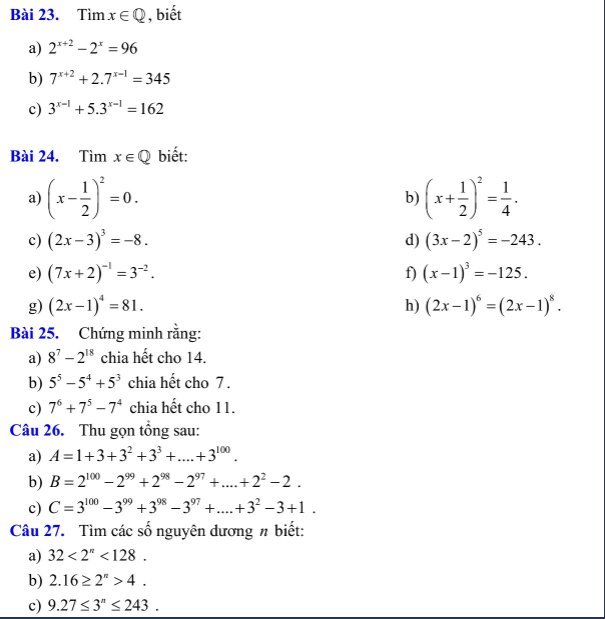
Hãy nhập câu hỏi của bạn vào đây, nếu là tài khoản VIP, bạn sẽ được ưu tiên trả lời.


Lũy thừa có thể hiểu là tích số của một số với chính nó nhiều lần. Luỹ thừa ký hiệu là \(a^b\) , đọc là lũy thừa bậc b của a hay a mũ b , số a gọi là cơ số, số b gọi là số mũ. Ngoài ra, ta cần biết rằng, phép toán ngược với phép tính lũy thừa là phép khai căn.
Đ/N:Lũy thừa được viết dưới dạng an, gồm cơ số a và số mũ là n.
C/T : an = a.a.............a ( n thừa số a ) ( n khác 0 ).

⇒ ( 4x + 28 ) . 3 + 55 = 35 . 5
⇒ ( 4x + 28 ) . 3 + 55 = 175
⇒ ( 4x + 28 ) . 3 = 175 - 55
⇒ ( 4x + 28 ) .3 = 120
⇒ 4x + 28 = 120 : 3
⇒ 4x + 28 = 40
⇒ 4x = 40 - 28
⇒ 4x = 12
⇒ x = 12: 4
⇔ x = 3.
Vậy x= 3.
\(\left[\left(4x+28\right)\times3+55\right]\div5=35\)
\(\left(4x+28\right)\times3+55=175\)
\(12x+84+55=175\)
\(12x=175-55-84\)
\(12x=36\)
\(x=3\)

\(a,x\left(y-z\right)+y\left(z-x\right)+z\left(x-y\right)\\ =xy-xz+yz-xy+xz-yz\\ =\left(xy-xy\right)+\left(xz-xz\right)+\left(yz-yz\right)\\ =0+0+0\\ =0\left(dpcm\right)\)
\(b,x\left(y+z-yz\right)-y\left(z+x-zx\right)+z\left(y-x\right)\\ =xy+xz-xyz-yz-xy+xyz+yz-xz\\ =\left(xy-xy\right)+\left(xz-xz\right)+\left(xyz-xyz\right)+\left(yz-yz\right)\\ =0+0+0+0\\ =0\left(dpcm\right)\)

a)
\(P=\left(x^{14}-9x^{13}\right)-\left(x^{13}-9x^{12}\right)+\left(x^{12}-9x^{11}\right)-...+\left(x^2-9x\right)-\left(x-9\right)+1\)
\(=x^{13}\left(x-9\right)-x^{12}\left(x-9\right)+x^{11}\left(x-9\right)+...+x\left(x-9\right)-\left(x-9\right)+1\)
\(P\left(9\right)=1\)
b)
\(Q=\left(x^{15}-7x^{14}\right)-\left(x^{14}-7x^{13}\right)+\left(x^{13}-7x^{12}\right)-...-\left(x^2-7x\right)+\left(x-7\right)+2\)
\(=x^{14}\left(x-7\right)-x^{13}\left(x-7\right)+x^{12}\left(x-7\right)-...-x\left(x-7\right)+\left(x-7\right)+2\)
\(Q\left(7\right)=2\)

\(\dfrac{x+4}{2010}+\dfrac{x+3}{2011}=\dfrac{x+2}{2012}+\dfrac{x+1}{2013}\)
\(\left(\dfrac{x+4}{2010}+1\right)+\left(\dfrac{x+3}{2011}+1\right)=\left(\dfrac{x+2}{2012}+1\right)+\left(\dfrac{x+1}{2013}+1\right)\)
\(\dfrac{x+2014}{2010}+\dfrac{x+2014}{2011}-\dfrac{x+2014}{2012}-\dfrac{x+2014}{2013}=0\)
\(\left(x+2014\right)\times\left(\dfrac{1}{2010}+\dfrac{1}{2011}-\dfrac{1}{2012}-\dfrac{1}{2013}\right)=0\)
Vì \(\dfrac{1}{2010}+\dfrac{1}{2011}-\dfrac{1}{2012}-\dfrac{1}{2013}\ne0\)
=> \(x+2014=0\)
\(x=0-2014\)
\(x=-2014\)

Lời giải:
Ta thấy:
$|x-3|+|x-5|=|x-3|+|5-x|\geq |x-3+5-x|=2$ nên không tồn tại $x$ thỏa mãn $|x-3|+|x-5|=0,(6)$

\(\dfrac{x+1}{10}+\dfrac{x+1}{11}+\dfrac{x+1}{12}=\dfrac{x+1}{13}+\dfrac{x+1}{14}\)
\(\dfrac{x+1}{10}+\dfrac{x+1}{11}+\dfrac{x+1}{12}-\dfrac{x+1}{13}-\dfrac{x+1}{14}=0\)\(\left(x+1\right)\times\dfrac{1}{10}+\left(x+1\right)\times\dfrac{1}{11}+\left(x+1\right)\times\dfrac{1}{12}-\left(x+1\right)\times\dfrac{1}{13}-\left(x+1\right)\times\dfrac{1}{14}=0\)
\(\left(x+1\right)\times\left(\dfrac{1}{10}+\dfrac{1}{11}+\dfrac{1}{12}-\dfrac{1}{13}-\dfrac{1}{14}\right)=0\)
Vì \(\dfrac{1}{10}+\dfrac{1}{11}+\dfrac{1}{12}-\dfrac{1}{13}-\dfrac{1}{14}>0\)
=> \(x+1=0\)
\(x=0-1\)
\(x=-1\)
\(\dfrac{x+1}{10}+\dfrac{x+1}{11}+\dfrac{x+1}{12}=\dfrac{x+1}{13}+\dfrac{x+1}{14}\\ \Rightarrow\dfrac{x+1}{10}+\dfrac{x+1}{11}+\dfrac{x+1}{12}-\dfrac{x+1}{13}-\dfrac{x+1}{14}=0\\ \Rightarrow\left(x+1\right)\left(\dfrac{1}{10}+\dfrac{1}{11}+\dfrac{1}{12}-\dfrac{1}{13}-\dfrac{1}{14}\right)=0\\ \Rightarrow x+1=0\left(\dfrac{1}{10}+\dfrac{1}{11}+\dfrac{1}{12}-\dfrac{1}{13}-\dfrac{1}{14}\ne0\right)\\ \Rightarrow x=-1\)

b) Ta có:
P(x) + H(x) = x4 - x3 + 2x2 + x + 1
=> H(x) = x4 - x3 + 2x2 + x + 1 - P(x)
=> H(x) = (x4 - x3 + 2x2 + x + 1) - (2x4 - x2 + x - 2)
=> H(x) = -x4 - x3 + 3x2 + 3
Vậy H(x) = -x4 - x3 + 3x2 + 3

Bạn nên ghi đề bằng công thức toán (biểu tượng $\sum$ góc trái khung soạn thảo) để được hỗ trợ tốt hơn. Viết như thế này khá khó đọc.